OPEC
Organization of Petroleum Exporting Countries (OPEC) members ALGERIA, INDONESIA, IRAN, IRAQ, KUWAIT, LIBYA, NIGERIA, QATAR, SAUDI ARABIA, UNITED ARAB EMIRATES, and VENEZUELA produce about 40% of the world's oil and hold more than 77% of the world's proven oil reserves. OPEC also contains most of the world's excess oil production capacity.
MEMBERS PRODUCTION
| Algeria | |
| Minister's name: | Chakib Khelil |
| Feb 2001 output: | 810,000 b/d |
| Apr 1 quota: | 773,000 b/d |
| Positioning: | Driven by a need to keep revenues from natural gas high, Algeria historically has been an OPEC price hawk, often seeking to persuade the organization to cut production in order to raise prices. |
| Indonesia |
|
|
Minister's name: |
Purnomo Yusgiantoro |
|
Feb 2001 output: |
1.27-mil b/d |
| Apr 1 quota: | 1.255-mil b/d |
|
Positioning: |
An OPEC pragmatist, Indonesia typically acts to help keep agreements intact or to achieve consensus across the group. Indonesia's current production quota is 1.385-mil b/d but it cannot produce to this level. |
| Iran |
|
|
Minister's name: |
Bijan Zanganeh |
|
Feb 2001 output: |
3.76-mil b/d |
| Apr 1 quota: | 3.552-mil b/d |
|
Positioning: |
Like Algeria, Iran has been hawkish in its outlook for many years, partly because its ability to export more crude oil has been circumscribed by a geological ceiling and rapidly rising domestic oil consumption. |
| Iraq |
|
|
Minister's name: |
Amer Rasheed |
|
Feb 2001 output: |
2.02-mil b/d |
|
Apr 1 quota |
Not a party to current OPEC production |
|
Positioning: |
Not really a participant since 1990, when its invasion of Kuwait brought strict international sanctions against Baghdad which effectively place oil policy in the hands of the UN. |
| Kuwait |
|
|
Minister's name: |
Adel al-Subih |
|
Feb 2001 output: |
2.06-mil |
|
Apr 1 quota |
1.941-mil b/d |
|
Positioning: |
Often acts in concert with Saudi Arabia, Qatar and the UAE, though in the past preoccupied with demanding an increase in its OPEC production quota. |
| Libya: |
|
|
Head of Delegation's name: |
Ahmed Abdulkarim Ahmed, Acting Chairman National Oil Corp |
|
Feb 2001 output: |
1.39-mil b/d |
|
Apr 1 quota: |
1.941-mil b/d |
|
Positioning: |
Once the third vocal price hawk of the group, Libya has in recent years been more inclined to accede to collective decisions. |
| Nigeria |
|
|
Head of Delegation's name: |
Rilwanu Lukman, Presidential Adviser on Petroleum |
|
Feb 2001 output: |
2.1-mil b/d |
|
Apr 1 quota: |
1.993-mil b/d |
|
Positioning: |
Normally a pragmatic player, if sometimes frustrated by OPEC's tendency to focus on the needs of rich Middle Eastern producers. A notorious quota-buster in the past, it has come into line with OPEC aims in recent months - if only because of community unrest in the oil producing regions. |
| Qatar |
|
|
Minister's name: |
Abdullah al-Attiyah |
|
Feb 2001 output: |
690,000 b/d |
|
Apr 1 quota |
627,000 b/d |
|
Positioning: |
An inveterate quota violater, Qatar's primary interest is in its natural gas production. Its constant but small overproduction of oil over the past 10 years has been so much a part of the scene that other OPEC members tolerate it. |
| Saudi Arabia
|
|
|
Minister's name: |
Ali Naimi |
|
Feb 2001 output: |
8.24-mil b/d |
|
Apr 1 quota: |
7.865-mil b/d |
|
Positioning: |
The kingpin of the organization by virtue of its huge production capacity. Saudi Arabia has more strategic flexibility than the rest of OPEC, but is sometimes constrained by short-term need for cash. Its goal for the past several years has been price stability at levels which won't destroy oil demand in the long run, but its analysis of supply and demand led it in late 1997 to push OPEC into a production hike which crashed prices. |
| UAE |
|
|
Minister's name: |
Obaid al-Nasseri |
|
Feb 2001 output: |
2.24-mil b/d |
|
Apr 1 quota: |
2.113-mil b/d |
|
Positioning: |
Of the seven emirates which make up the UAE, only Abu Dhabi truly participates in OPEC decision-making. In recent years, the UAE has typically followed the Saudi lead. |
| Venezuela |
|
|
Minister's name: |
Alvaro Silva Calderon |
|
Feb 2001 output: |
2.92-mil b/d |
|
Apr 1 quota: |
2.786-mil b/d |
|
Positioning: |
Once a major thorn in the side of those seeking rigorous production controls in OPEC, Venezuela has dropped its aggressive overproduction stance since changing governments in 1998 and now meets regularly with Saudi Arabia and non-OPEC Mexico to discuss market developments |
RECENT DEVELOPMENTS
Oil prices collapsed on September 24, in the largest single day price drop since January 1991. The September 11 terrorists attacks inside the U.S. and the world economic downturn appear to have precipitated new OPEC flexibility regarding its $25 price target for its basket of crude oils. Two days after the oil price collapse, on September 26, OPEC held its already-scheduled meeting and refrained from altering production quotas, despite the basket price hovering near two-year lows.
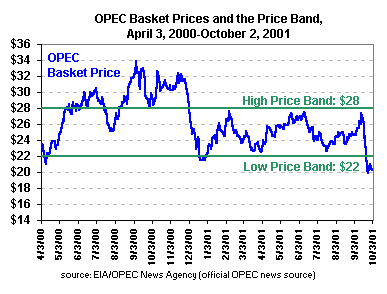 During its March 2000 meetings, OPEC adopted an informal price band mechanism
(formally ratified on January 17, 2001) whereby OPEC basket prices higher than
$28 per barrel or lower than $22 per barrel would trigger automatic production
adjustments. Prices sustained above the price band's target range for 20 trading
days are to result in a pro rata production increase of 500,000 bbl/d,
while prices below the target range for 10 trading days are to result in pro
rata cuts of 500,000 bbl/d.
During its March 2000 meetings, OPEC adopted an informal price band mechanism
(formally ratified on January 17, 2001) whereby OPEC basket prices higher than
$28 per barrel or lower than $22 per barrel would trigger automatic production
adjustments. Prices sustained above the price band's target range for 20 trading
days are to result in a pro rata production increase of 500,000 bbl/d,
while prices below the target range for 10 trading days are to result in pro
rata cuts of 500,000 bbl/d.
Kuwaiti Oil Minister Adel Al-Subeih has stated that the band is intended for use during "normal" periods, not times of volatile markets and economic uncertainties. Hence, it would not be appropriate to use the mechanism at the current time. EIA expects oil prices in 2002 that will keep the basket price near the low end of it price band.
In the 19-month history of the price band, the mechanism has seldom been used. In 397 days of trading, OPEC's basket price has closed above OPEC's upper $28 band 121 times and below the lower $22 band 16 times (through October 2). In decisions reached at OPEC meetings (and one decision reached during a conference call), OPEC has raised its quotas three times and reduced its quotas three times. Only one of these quota changes was the result of a price band activation.
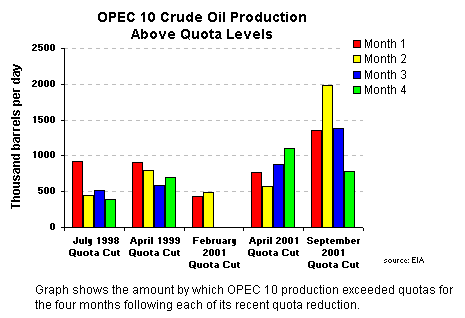
OPEC COMPLIANCE
Prior to September 11, EIA had not anticipated OPEC fulfilling its September 1,
1-million-bbl/d quota reduction. Events since that date have made it
increasingly likely that OPEC production will greatly exceed its quota levels in
the fourth quarter of 2001. Over-production is expected to spike in October,
with production approaching February 2001 quota levels.
OPEC's unusually low quota compliance comes as members contemplate how to manage competing interests: OPEC's share of world oil markets and high oil prices. In the last year and a half, OPEC appears to have been defending price at the expense of market share, a situation that might be changing. Adding to OPEC's woes is the possibility that non-OPEC production in 2002 might outpace world demand growth.
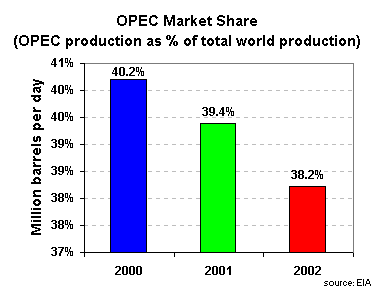 World Oil Demand
World Oil Demand
In its previous Outlook, EIA noted that world oil demand during the past decade
grew by at least 1 million barrels per day except during periods of serious
international crises. A week after the release of the Outlook, the world did
indeed enter a serious political and economic crisis, and moved closer to a
global recession. In the near-term, the largest impact is expected to come from
the large drop in global demand for jet fuel. Worldwide jet-fuel demand probably
fell by about 10 percent outside the United States and by as much as twice that
much within the United States. EIA's Outlook for 2002 assumes that following the
initial stages of the crisis, commercial jet fuel use will recover somewhat, and
that global jet fuel demand will be down by roughly 5 percent.
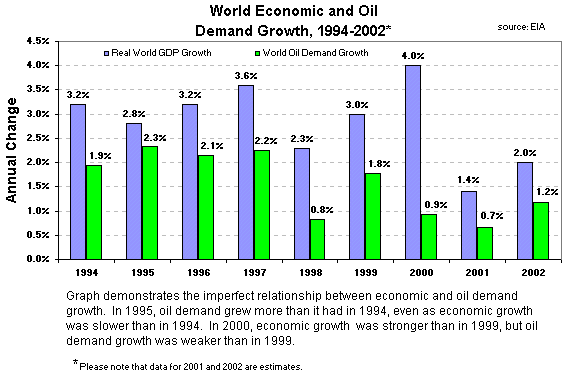
In 2001, the OPEC 10 have been proactive in making production quota cuts in anticipation of market conditions that could weaken prices for their crude oils. They have been especially sensitive to weakening oil demand. However, the recent turmoil in world oil markets has left OPEC cautious about responding to the latest downturn in demand. Iranian Oil Minister Bijan Zanganeh stated that "the current situation is not because of the fundamentals in the market-- I believe there is no reason to panic." This sentiment was echoed by Saudi Arabian Oil Minister Ali Naimi, who suggested that OPEC should allow time for existing output curbs to be felt in a world oil market where crude prices have slumped under the threat of an impending economic downturn. "This is not a good time to react quickly to what is happening in the market."
World Oil Inventories
At the beginning of September, OECD commercial oil stocks were estimated to be
at the bottom end of their normal range, only slightly higher than last year's
extremely low levels. Prior to the crisis, the EIA Outlook indicated that unless
the OPEC 10 eased off their new quotas, there was a very real possibility that
these low inventories would create upward pressure on oil prices as the winter
heating season approached.
With the large increase in OPEC 10 production that began during September 2001 and the decline in world oil demand, OECD commercial stocks are projected to loosen and move into the middle of their normal range in 2002. The EIA Outlook does not factor in stock-building in anticipation of a possible shortage that could occur as a result of the events of September 11, although there have been indications that some stockpiling may have occurred immediately after these events.
EIA does not attempt to estimate oil inventory levels on a global basis. However, the direction in which OECD commercial oil inventories are headed is discerned from EIA's world oil supply and demand estimates.
IRAQ
In September, Iraq averaged about 1.9 million bbl/d in United Nations-sanctioned
oil-for-food exports. While weekly levels continue to fluctuate, exports resumed
quickly after Iraq's four-week suspension in June-July. Although controversies
related to pricing policies for Iraqi crude continue and Iraqi exports typically
fall at the end of each phase of the UN's oil-for-food program, no other major
disruptions in exports are expected in the near term.
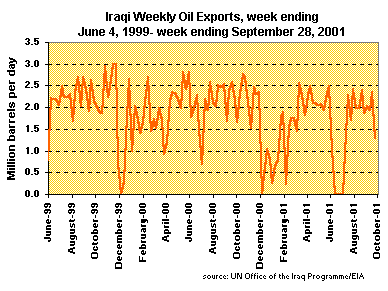
There have been repeated pricing controversies in recent months. In an effort to illegally generate income for the regime through oil exports, Iraq often charges a "surcharge" on top of the UN-approved selling price for the crude that is outside the purview of UN supervision. Iraq has tried to sell its oil for official prices that the UN believes are below-market levels. The differential between the official price and the market price for Iraqi oil allows room for the illegal surcharge, which has been estimated by UN Security Council experts at $0.30 per barrel compared with a typical premium of $0.05 per barrel earned by traders.
The United States and the United Kingdom have asked for more frequent price analyses by in-house UN oil industry experts, alerting the UN sanctions committee when official selling prices diverge from values on the cash market. In September, the Security Council agreed to receive weekly updates on oil prices from the oil overseers. Iraq has countered that its prices should be more stable and approved no more frequently than once a month. UN Security Council members Russia and China also object to more frequent pricing reviews.
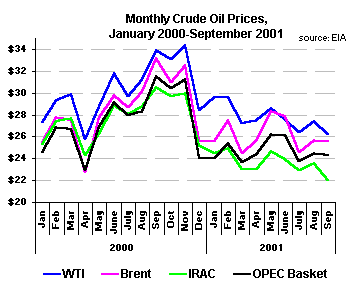 WORLD OIL PRICING
WORLD OIL PRICING
OPEC collects pricing data on a "basket" of seven crude oils,
including: Algeria's Saharan Blend, Indonesia's Minas, Nigeria's Bonny Light,
Saudi Arabia's Arab Light, Dubai's Fateh (or Dubai), Venezuela's Tia Juana
Light, and Mexico's Isthmus (a non-OPEC crude oil). It uses the price of this
basket to monitor world oil market conditions, and the basket price triggers the
price band mechanism.
Major world crude oils important for oil pricing, called "benchmark" crudes, include U.S. West Texas Intermediate (WTI) and North Sea Brent crude. Because WTI is a very light, sweet (low sulfur content) crude, it is generally more expensive than the OPEC basket, which is an average of light sweet crude oils such as Algeria's Saharan Blend and heavier sour crudes (with high sulfur content) such as Dubai's Fateh. Brent is also lighter, sweeter, and more expensive than the OPEC basket, although less so than WTI. WTI generally trades at about a $2 premium to Brent.
The average price for imported oil paid by U.S. refiners is referred to as the Imported Refiners' Acquisition Cost (IRAC). This average cost for imported oil is used as a proxy for the average world oil price, and is the world oil price used in EIA's Short-Term Energy Outlook. The IRAC price and OPEC basket price have tracked closely during the past few years. However, in recent months, the IRAC price has tracked lower than usual. The OPEC basket has been $1+ higher than the IRAC, while WTI has been $3 higher than IRAC.
|
OPEC Crude Oil Production 1 |
|||||
|---|---|---|---|---|---|
|
3Q 2001 Production |
4Q 2001 Production |
9/01/01 Quota2 |
4Q Production Capacity3 |
4Q Surplus Capacity3 | |
|
Algeria |
825 |
773 |
741 |
975 |
202 |
|
Indonesia |
1,214 |
1,203 |
1,203 |
1,250 |
47 |
|
Iran |
3,733 |
3,571 |
3,406 |
3,900 |
329 |
|
Kuwait4 |
2,004 |
1,995 |
1,861 |
2,200 |
205 |
|
Libya |
1,362 |
1,326 |
1,242 |
1,550 |
224 |
|
Nigeria |
2,071 |
2,166 |
1,911 |
2,300 |
134 |
|
Qatar |
685 |
654 |
601 |
735 |
81 |
|
Saudi Arabia4 |
8,104 |
8,000 |
7,541 |
10,000-10,5005 |
2,000-2,5005 |
|
UAE6 |
2,148 |
2,141 |
2,025 |
2,650 |
509 |
|
Venezuela |
2,822 |
2,754 |
2,670 |
3,100 |
346 |
|
OPEC 10 Crude Oil Total |
24,969 |
24,583 |
23,200 |
28,660 - 29,1605 |
4,077 - 4,5775 |
|
Iraq7 |
2,604 |
2,382 |
N/A |
3,000 |
618 |
|
OPEC Crude Oil Total |
27,573 |
26,965 |
31,660 - 32,1605 |
4,695 - 5,1955 | |
|
Other Liquids8 |
2,771 |
2,771 |
|||
|
Total OPEC Production |
30,344 |
29,736 |
|||
NA: Not Applicable
1Crude oil does not include lease condensate or natural gas liquids.
2Quotas are based on crude oil production only.
3Maximum sustainable production capacity, defined as the maximum
amount of production that: 1) could be brought online within a period of 30
days; and 2) sustained for at least 90 days.
4Kuwaiti and Saudi Arabian figures each include half of the
production from the Neutral Zone between the two countries. Saudi Arabian
production also includes oil produced from its offshore Abu Safa field on behalf
of Bahrain.
5 Saudi Arabia is the only country with the capability to further
increase its capacity significantly within 90 days. Saudi Arabia can increase
its sustainable production capacity to 10 million bbl/d within 30 days and to
10.5 million bbl/d within 90 days. As a result, the estimates for Saudi Arabia
are as shown as a range, with the lower figure using the 30 days' definition and
the upper end reflecting Saudi Arabia's 90 days' capability. OPEC's surplus
capacity estimates are also shown as a range for this reason.
6The UAE is a federation of seven emirates. The quota applies only to
the emirate of Abu Dhabi, which controls the vast majority of the UAE's economic
and resource wealth.
7Iraqi oil exports are approved by the United Nations under the
oil-for-food program for Iraq established by Security Council Resolution 986
(April 1995) and subsequent resolutions. As a result, Iraqi production and
exports have not been a part of any recent OPEC agreements. Resolution 986
limited the sale of Iraqi crude oil over six-month periods to specified dollar
amounts. However, the Security Council voted to remove any limits on the amount
of oil Iraq could export in December 1999.
8Other liquids include lease condensate, natural gas liquids, and
other liquids including volume gains from refinery processing.
MEETINGS, ANNOUNCEMENTS, AND RELATED EVENTS
The OPEC 10 countries hold meetings at OPEC headquarters in Vienna, Austria,
where they decide issues and make announcements that influence world oil markets
and prices. Major decisions and announcements in 2001 include:
January 17, 2001: OPEC agreed to cut production quotas by 1.5 million bbl/d, effective February 1, 2001.
March 16, 2001: OPEC agreed to cut production quotas by 1 million bbl/d, effective April 1, 2001.
June 1, 2001: The ninth phase of the oil-for-food program concluded; the United Nations approved a 30-day rollover of the program.
June 4, 2001: Iraq halted oil-for-food exports.
June 5, 2001: OPEC held its 115th meeting to review the state of world oil markets, leaving quotas unchanged.
July 3, 2001: OPEC held its 116th meeting to discuss the impact of Iraqi oil export cuts, again leaving quotas unchanged. Also, the one-month rollover of the oil-for-food program ended, and the UN approved another five months of the program with Security Council Resolution 1360.
July 10, 2001: Iraq resumed oil-for-food exports.
July 25, 2001: OPEC agreed to cut production quotas by 1 million bbl/d, effective September 1, 2001.
September 26, 2001: OPEC held its 117thmeeting to review world oil markets, leaving production quotas unchanged.October 5, 2001: The OPEC basket price will have remained below $22 for 10 trading days (assuming price trends as of October 2 continue until October 5), raising the possibility that the price band mechanism could be activated.
November 14, 2001: OPEC will hold its 118th meeting to review oil markets.
November 30, 2001: The current phase of Iraq's oil-for-food program
will end.
BACKGROUND
The Organization of Petroleum Exporting Countries (OPEC) was founded in Baghdad,
Iraq, in September 1960, to unify and coordinate members' petroleum policies.
OPEC members' national oil ministers meet regularly to discuss prices and, since
1982, to set crude oil production quotas. Original OPEC members include Iran,
Iraq, Kuwait, Saudi Arabia, and Venezuela. Between 1960 and 1975, the
organization expanded to include Qatar (1961), Indonesia (1962), Libya (1962),
the United Arab Emirates (1967), Algeria (1969), and Nigeria (1971).
Ecuador
and
Gabon
were members
of OPEC, but Ecuador withdrew in December 1992, and Gabon followed suit in
January 1995. EIA estimates the current eleven OPEC members account for roughly
40% of world oil production and about 77% of the world's proven oil reserves.
For more information on OPEC, see these other sources on the EIA web site:
EIA Information on OPEC
Monthly Energy
Chronology
Non-OPEC Fact Sheet
Persian Gulf Oil Export
Fact Sheet
Short-Term Energy
Outlook - International Petroleum Supply and Demand with OPEC Production
The following links are provided solely as a service to our customers, and therefore should not be construed as advocating or reflecting any position of the Energy Information Administration (EIA) or the United States Government. In addition, EIA does not guarantee the content or accuracy of any information presented in linked sites.
OPEC's Home Page
OPEC - International Energy Forum
November 17-19 2000
OPEC News (unaffiliated with OPEC's Official
Page)
United Nations Office of the Iraq
Programme